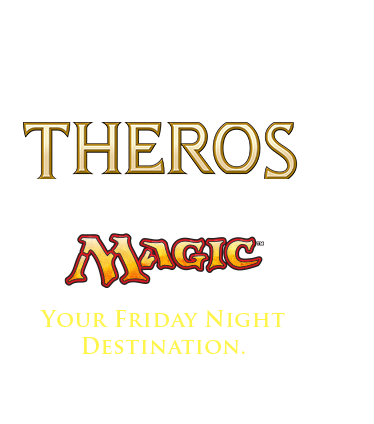I Second That Devotion
Welcome to Devotion Week. This week, we'll be talking all about the devotion mechanic from Theros block. By the time you finish this article you will know a lot about the devotion mechanic. How it came to be. How it got to print. How it came to see print again but with a new name and flavor. Devotion (kind of formerly known as chroma)—this is your life.
- Fifth Dawn of a Mechanic
The origin of devotion goes back to the design of Fifth Dawn, the third set in the Mirrodin block. It was a quirky design team that included myself as the team lead, Randy Buehler (who at the time was a Magic developer), Greg Marques (a man who would later come to work for Wizards but at the time did not—here is the story of how he got on the design team while not working at Wizards), and Aaron Forsythe. Be aware that, at the time, Aaron didn't work in Ramp;D. He was the original editor-in-chief of magicthegathering.com. Randy suggested including Aaron to get a different vantage point and allow for a pretty cool article.
Aaron ended up doing awesomely, coming up with both the two new mechanics in the set, scry and sunburst. This would lead us to giving him a job in Ramp;D. Aaron would ultimately parlay that into a job as the director of Magic Ramp;D. Anyway, in Fifth Dawn design, Aaron turned in the following card:
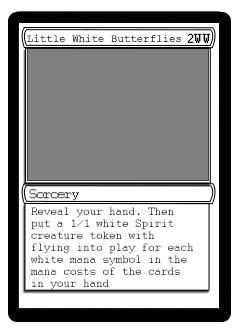
I liked the card and put it into the file. Aaron then turned in a second card:
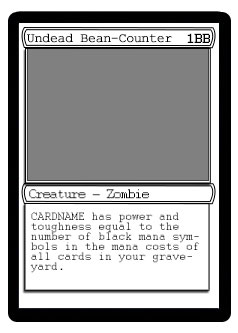
I liked this one even more. So much that not only didn't I put it into the set but I removed Little White Butterflies. Why? Because I realized that Aaron had stumbled onto a mechanic with a lot of potential. It was something bigger than just a card or two. Also, Fifth Dawn, being an artifact set with a smaller number of colored mana symbols than normal was the absolute wrong place for this mechanic.
I thought about the mechanic during Ravnica block but it lost out to other things. I also thought about it for Time Spiral and Planar Chaos but it wasn't time related or nostalgic, so it didn't fit. But when I came to Future Sight and started trying to find mechanics from the future, I knew I found a home for the mechanic—true, only on one card, but that card would hint at the future use of the mechanic. The creative team named it chroma. This was the card it appeared on:
And thus chroma was officially a mechanic, even if only as a glimpse.
- Prince of Eventides
A year later, I was about to start up the design for Eventide. When we had made the futureshifted cards, I had decided that I wanted the next year's expansions, all four, to each have a futureshifted card in it. I had tentatively chosen to have Phosphorescent Feast appear in Eventide, which meant the set would have the chroma ability word.
We played around with chroma and ended with nine cards with the ability:
Fiery Bombardment
Heartlash Cinder
Light from Within
Outrage Shaman
Phosphorescent Feast
Primalcrux
Sanity Grinding
Springjack Shepherd
Umbra Stalker
All but three of the cards cared about mana symbols in mana costs of cards on the battlefield. Phosphorescent Feast cared about mana costs of cards in the hand, Sanity Grinding cared about mana costs of cards in the library, and Umbra Stalker cared about mana costs of cards in the graveyard. The set came out and the response to the chroma mechanic was lukewarm. Players didn't hate the mechanic but they didn't love it either. The reaction was very blah. Note that the Eventide set in general was received poorly, so while chroma didn't fare too well, it was received better than average for the set.
I was disappointed, because I saw great promise in chroma. I felt like we had messed up somehow. The mechanic was better than its reception. The big question was what had we done wrong? I spent many years contemplating the answer. (And I promise to fill you in on what I learned, below.)
- Theros-Colored Glasses
We now flash forward to Theros design. Many years ago, Bill Rose realizing that we needed to be better at maintaining our design resources laid down a dictum that we had to start bringing back a mechanic at least once each block. I had come to the same conclusion and agreed with Bill that it was a good idea. This meant that, sometime early in design, I always asked the design team to think about what mechanic(s) should come back.
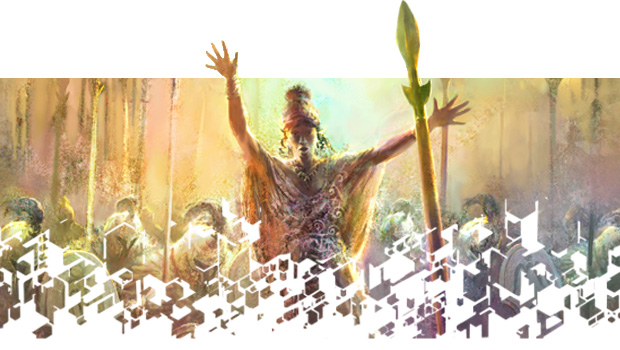
When this happened in Theros design, Zac Hill, the development representative on the design team, said he had an idea. What about chroma? Zac and I had talked about the mechanic and he agreed with me that it was a better mechanic than its reception implied. I had stated on many occasions that I wanted to give chroma a second chance. Zac said he thought chroma might be a good fit because Theros was going to be a set with a lot of enchantments on the battlefield, which meant that it would have more colored mana symbols to count.
The reason I was excited by chroma was that I knew we needed a mechanic that reflected the denizens' feelings for the gods. So much of Greek mythology was concerned with the worship of the gods that I knew the set needed something to capture that flavor. When I had tried to come up with a new mechanic to represent that worship, I kept coming up with things similar to chroma. When Zac spoke up, I was eager to agree with the idea.
Here was the problem: Obviously, we had done something wrong with chroma last time. If we were going to bring it back, we had to understand what went wrong so we could fix it. Here is the list of things I realized that needed to be fixed:
- #1: The Flavor
On the function-to-flavor scale, where the absolute of the one side is pure function without flavor and the absolute of the other side is pure flavor without function (you can think of this as the Melvin/Vorthos scale), chroma was way too far on the function side. It did a thing that was interesting but completely devoid of any flavor. While there are many players who will say it doesn't matter, time has showed us that it does.
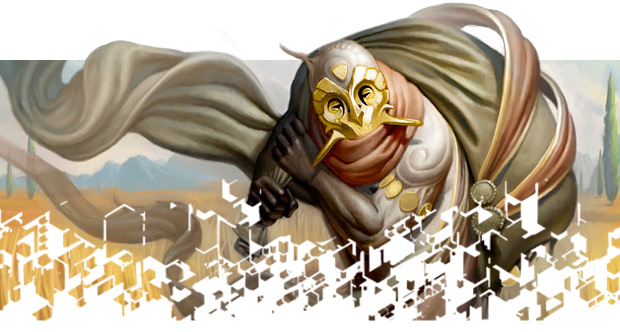
Ramp;D has learned the importance of resonance—of players being aided in understanding a card because the card carries with it a meaning and a connection that allows the players to use preexisting information to help them process it. When a mechanic has a flavor, it helps the players bond with it and comprehend it faster. It also helps the overall aesthetic, because the mechanic feels right.
Chroma had been named during Future Sight, when the creative team was tasked with naming a score of new futureshifted mechanics. Normally, in the process, there are only a handful of new mechanic names needed, so the team has the luxury to find the perfect name. Future Sight upped the volume to the point that the team didn't have the luxury of time. The mechanic felt pretty mechanical because the design team hadn't given it any flavor. The creative team therefore gave it a very functional, but not flavorful, name.
Because I was eager to tie the card into the futureshifted cards, I took the mechanic with the name chroma. This lack of flavor only furthered itself because the name did not evoke anything that would get the designers to design around it. Non-flavorful execution led to a non-flavorful name, which led to more non-flavorful executions.
The good news was I had the perfect fit for the flavor of the mechanic. It was going to represent the devotion the people had toward their gods. One of the reasons that I decided this was the time to try to bring back chroma was that we had finally found a flavor that fit.
- #2: The Name
I'm a word guy. I have spent my entire life playing around with words and I'm a firm believer that words have a lot of power. Giving something a proper name gives it meaning, and that meaning gives it power. It allows people to talk about it and it, in turn, spurs how people think about it.

Chroma was a bad name. It was functional (chroma meaning "color" in Latin) but it was boring. Yes, it referred to an aspect of the mechanic—it looked at colored mana symbols) but it did nothing to make the mechanic have any substance to it. It wasn't quite as bad a name as "Counts Colored Mana Symbols" but it wasn't that far away.
The solution to this problem was pretty clear. I had to give it a new name. That proved to be pretty easy because as soon as I decided I had to change chroma to a new name, "devotion" quickly popped into my head. I wasn't quite done just yet, though. Another thing the name chroma did poorly was that it didn't tell you which color you cared about. I felt that the color was important enough that I wanted it worked into the name. "[Color name] devotion" felt a little strained so I tried "devotion to [color name]" and that felt right.
- #3: The Functionality
You'll see a running theme as I explain some of the promises with chroma. There were decisions made in Future Sight that would later impact the mechanic, although not a lot of thought was put into the decisions when they were first made. Above, I talked about a decision the creative team made. This time, I'll talk about one that design made.

Phosphorescent Feast looks at the hand. Why? I don't know. It could have just as easily looked at the battlefield. But because I made that choice when I designed the card and I really wanted to support Future Sight by using the futureshifted card, I forced chroma to matter about more than one thing.
You see, when Eventide design playtest started, we had blue and green (because of Phosphorescent Feast) look at the hand, black look at the graveyard, and red and white look at the battlefield. We quickly learned that the most fun was with the ones that looked at the battlefield. Note that over half of the printed cards look at the battlefield. But we were locked into using Phosphorescent Feast, so that forced us to make the mechanic be broader.
When we had a chance to reinvent the mechanic, I knew I wanted to lock it to the battlefield.
First off, it matched the flavor I wanted. How do you show your devotion? By having a lot of cards of that color in play.
Second, it allowed us some more flexibility in how we used it (more on this in a second). Making the change had another benefit. I knew we needed to change the name. Chroma did not fit the flavor we wanted for the mechanic. By slightly changing the functionality, I forced the change. If Theros's version did not function exactly like the Eventide version it had to have a new name.
Third, it just played better. The mistake I made in Future Sight was a simple one. I didn't have enough chance to playtest it. It was just one card in a file. That meant it didn't get played often and, when it did, it always had the same function. We weren't able to realize that counting mana symbols on the battlefield was better because there didn't even exist a card that did it. Once Eventide had a volume of cards to playtest with, we realized the improved play value very quickly.
- #4: The Ability Word
Once again, a decision made on the one card in Future Sight forced our hand. On Phosphorescent Feast, chroma was an ability word and not a keyword. This is a little bit technical so please stay with me. A keyword is a word that represents an ability that is constant. The keyword is a shorthand for that longer meaning. This means that every card that uses the same keyword has to use it in the same way. Chroma, because it changed where it looked at to count the mana symbols, couldn't be a keyword.
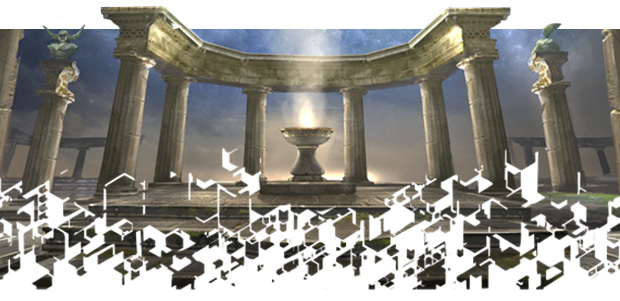
Ability words are a naming convention to group like things together that cannot be keyworded. The way you can tell something is an ability word is twofold. First, it is always in italics, with a dash at the beginning of the rules text. Second, if removed from the card, the rules text would still read perfectly fine. Keywords, in contrast, are within the rules text and would make the text incomplete if removed.
Why does it matter if it's a keyword or an ability word? Two reasons. First, consistency is important. Having a mechanic always work the same way just makes it easier for players to grok. Second, and this is the more important one for Theros, you are not allowed by the rules of the game to reference ability words. What exactly does that mean? It means that I can say "All creatures you control with [keyword] are +1/+1" but I cannot say "All creatures you control with [ability word] are +1/+1."
This is crucial in Theros because we wanted to be able to have devotion impact other cards, the most important of which are, of course, the Gods. If we had just used chroma, the Gods could not have worked the way they currently work. To be fair, they could have had the functionality but they would not have been able to reference the mechanic, which undercuts the flavor we were going for. I very much wanted the Gods to mention the devotion by name.
- #5: The Power
Okay, this one really is a development thing and not a design thing, but it's important enough that I'm going to talk about it. When preparing this article I was talking with Erik Lauer, Theros's lead developer and Magic's head developer, about why chroma did so poorly. He had a simple answer: "The cards with it sucked."

Erik then explained that one of the things that makes a mechanic popular is that it has good cards. Playing with a mechanic that helps you win goes a long way to helping you like a mechanic. A big part of the failure of chroma, Erik believes, was the lack of tournament-relevant cards with the mechanic.
Erik worked hard to not repeat that mistake, and if you've taken a look at any post-Theros tournament results, especially in Standard, you'll see that this time around the mechanic didn't suffer the same fate. Having the mechanic lock down counting mana costs on the battlefield helped Erik and his team be able to better focus and cost the mechanic.
- Hopelessly Devoted
I never wavered in my quest to redo chroma, but I do know a few eyebrows were raised when I told people what I was planning. Redoing things people love is an easy sell. Redoing something that wasn't successful the first time out is a bigger challenge. The key to winning people over was actually pretty simple, though. I just had them play with it. The naysayers all changed their tune once they got to experience devotion for themselves.
Publicly, devotion has done wonderfully. It has been embraced warmly by the playerbase and has made a showing in almost every format. I am happy to say it is now on a short list of mechanics I know we will do many times in Magic's future.
The best part of devotion's success for me, though, is the knowledge that mechanics can be reworked. Execution matters. Just because something we do fails doesn't mean the mechanic is unsalvageable. Magic has had plenty of successful mechanics in the past, but seeing how chroma was remade makes me eager to figure out what other diamonds in the rough are sitting in Magic's past.
- Devotion on the Floor
I hope you enjoyed my look today at the evolution of devotion. I'm curious what mechanics all of you think deserve a second chance. Please drop me an email, respond in the thread to this column, or contact me through my social media (Twitter, Tumblr, Google+) to let me know what mechanics from Magic's past deserve another go around. Maybe one of you will clue me into the next devotion.
That's all I have for today. Please join me next week when I offer a different way to look at life.
Until then, may you rediscover the hidden gems in your own past.
- "Drive to Work #74 – Invitationals, Part 2"
Today, I continue my look at the various Invitationals. In this podcast, I talk about the Duelist/Magic Invitationals in Barcelona and Kuala Lumpur.
- "Drive to Work #75 – Enchantments"
This podcast is my last one in my series on card types. It's finally time to talk about enchantments.
Multi |
- Episode 75: Enchantments (16.2 MB)
- Episode 74: Magic Invitational, Part 2 (18.8 MB)
- Episode 73: Magic Invitational, Part 1 (15.4 MB)
- Episode 72: Odyssey, Part 4 (22.0 MB)
- Episode 71: Odyssey, Part 3 (16.3 MB)
- Complete Drive To Work Podcast Archive



@maro254
Email Mark
Author Archive
Making Magic Archive
Working for Magic Ramp;D since October, 1995, Mark Rosewater is currently the head designer. His hobbies include spending time with his family, talking about Magic on every known medium (including a daily blog and a weekly podcast), and writing about himself in the third person.




